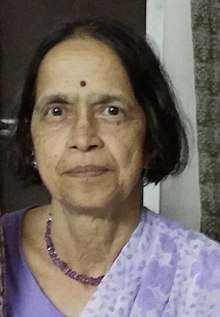Mangala Narlikar
Mangala Narlikar is Indian mathematician who has worked and taught in both advanced mathematics and simple arithmetic. After her degrees in mathematics, she initially worked at the Tata Institute of Fundamental Research (TIFR) in Mumbai and later worked as a lecturer in the University of Bombay and Pune.[1] She has published a number of books and articles both in English and Marathi language on mathematics related subjects. She is the recipient of the Vishwanath Parvati Gokhale Award 2002 for her Marathi book Gargi Ajun Jeevant Aahe - गार्गी अजून जिवंत आहे.[2]
Mangala Narlikar | |
|---|---|
 | |
| Born | Mangala Rajwade Bombay, India |
| Alma mater | University of Bombay, |
| Occupation | Mathematician |
| Spouse(s) | Jayant Narlikar |
| Children | 3 |
Biography
Narlikar studied from the University of Bombay and received degrees of B. A. (Maths) in 1962 and M.A. (Maths) in 1964 with first rank and also won the Chancellor’s gold medal.[1][3] She married, Jayant Narlikar, a well known cosmologist and physicist, in 1966. They have three daughters, Geeta, Girija and Leelavati, all of whom have pursued careers in science; one (Geeta) is a Professor of biochemistry at the University of California, San Francisco and other two are in computer science.[4][5]
From 1964 to 1966 Narlikar worked as a Research Student and Research Associate in the School of Mathematics of the Tata Institute of Fundamental Research, Mumbai. From 1967 to 1969 she taught the undergraduate school at the University of Cambridge. From 1974 to 1980 she again worked in the School of Mathematics of TIFR.[1] She obtained her Ph.D. degree in mathematics from the University of Bombay, 16 years after her marriage,[6] in 1981 on the subject of Analytic Number theory.[3] After obtaining her doctoral degree, she continued to work with TIFR from 1982-1985 as a Pool Officer in the School of Mathematics. Her teaching assignments from 1982 to 1985 was for M Phil class in the Department of Mathematics in the University of Bombay. She also taught at intervals in the department of Mathematics of the University of Pune from 1989 to 2002 and taught M Sc students at the centre in Bhaskaracharya Pratishthan from 2006 to 2010.[1]
Narlikar's core fields of interest are Real and Complex Analysis, Analytic Geometry, Number Theory, Algebra and Topology.[1]
On writing books on mathematics, Narlikar wrote: "I enjoyed writing a book on how to make Mathematics interesting and accessible".[7] On her combining her profession with looking after the household functions she wrote: "My story is perhaps a representation of the lives of many women of my generation who are well educated but always put household responsibilities before their personal careers".[5]
Publications
Narlikar has published a number of scientific papers and books which included:[1]
Papers
- Theory of Sieved Integers, Acta Arithmetica 38, 157 in 19
- On a theorem of Erdos and Szemeredi, Hardy Ramanujan Journal 3, 41, in 1980
- On the Mean Square Value theorem of Hurwitz Zeta function, Proceedings of Indian Academy of Sciences 90, 195, 1981.
- Hybrid mean Value Theorem of L-functions, Hardy Ramanujan Journal 9, 11 - 16, 1986.
- On orders solely of Abelian Groups, Bulletin of London Mathematical Society, 20, 211 - 216, in 1988.
- Several Articles on mathematics in Science Age, to create interest in Mathematics among lay people
Books
- Ganitachyaa Sopya Vata, a book in Marathi for school children
- An easy Access to basic Mathematics, a book for school children.
- A Cosmic Adventure, translation of a book on Astronomy by Professor J. V. Narlikar.
References
- "E-learning in Mathematics at Undergraduate and Postgraduate Level". Bhaskaracharya Pratishthana. Archived from the original on 20 April 2014. Retrieved 1 November 2015.
- "Gargi Ajun Jeevant Aahe - गार्गी अजून जिवंत आहे" (in Marathi). Online Book Store India indy.co.in. Archived from the original on 4 August 2016. Retrieved 1 November 2015.
- Chengalvarayan & Gokilvani 2007, p. 110.
- "Living Legends in Indian Science Jayant Vishnu Narlikar" (PDF). Current Science. Retrieved 1 November 2015.
- "Mangala Narlikar: The Journey of an Informal Mathematician: Academic Featured Biographies". Brainprick. 9 July 2012. Retrieved 1 November 2015.
- "Indian Women In Science". American Chemical Society. Retrieved 1 November 2015.
- "What Science Academies do for Indian Women in Mathematics" (PDF). The Institute of Mathematical Sciences. Retrieved 1 November 2015.
Bibliography
- Chengalvarayan, P.; Gokilvani, Srinivasan (1 January 2007). Women mathematicians: their contributions, a critique. Regal Publications. ISBN 978-81-89915-72-8.CS1 maint: ref=harv (link)